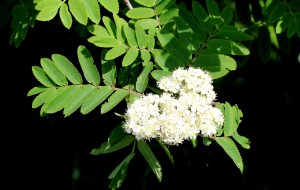 A prominent feature of the countryside in the last few weeks has been the rowan trees covered with their cascades of white blossoms. Although to many people the Scots pine or silver birch may be their favourite tree the rowan must surely come third in any popularity poll. The clue to one of the many reasons for this love of rowans lies in one of its alternative names, mountain ash. Whilst it is frequent along roadside verges, woodland edge and even moorland, it grows higher in the hills, very occasionally along with juniper and willow, than any other of the trees in the Highlands. To suddenly come upon a rowan tree well above any other on the high tops, and isolated, is quite an experience. In contrast, its reputed magic means that it has been planted beside old cairns and stone circles and around many of the older houses and, for that matter, some new ones.
A prominent feature of the countryside in the last few weeks has been the rowan trees covered with their cascades of white blossoms. Although to many people the Scots pine or silver birch may be their favourite tree the rowan must surely come third in any popularity poll. The clue to one of the many reasons for this love of rowans lies in one of its alternative names, mountain ash. Whilst it is frequent along roadside verges, woodland edge and even moorland, it grows higher in the hills, very occasionally along with juniper and willow, than any other of the trees in the Highlands. To suddenly come upon a rowan tree well above any other on the high tops, and isolated, is quite an experience. In contrast, its reputed magic means that it has been planted beside old cairns and stone circles and around many of the older houses and, for that matter, some new ones.
Rowan was thought to be more potent than any other tree against evil or bad luck so the timber was incorporated in a very wide range of objects. These included barrels, spinning wheels, butter churns and boats and many small household items. Perhaps the most bizarre was its use in coffins. A rowan wand for protection was placed above the doors of the house and out-houses and a more personal touch for such protection was to carry a sprig of rowan in your pocket. The rowan even had its medicinal uses as a concoction of rowan berries with apple and sugar was taken for whooping cough. Perhaps the most unusual use was with the bark that was made into a poultice for use in case of an adder bite. On the farm or croft, a rowan switch was used to herd sheep and cattle and a sprig was even attached to the cow’s tail to protect the milk. A sprig on a horse’s tail was supposedly to keep the evil eye from travellers.
However, many people know the rowan is for its attractive colouring in the Autumn and the wide use of its rich red berries. The autumn foliage is orange or scarlet as the leaves turn colour to make a visual spectacle that is very attractive. If this was not enough, after many of the leaves have fallen, the berries turn red and sometimes an even richer orange that is so beloved by birds. For ourselves it is the season for making drinks or jelly and, apart from the brambles, this is probably the berries picked the most in the Highlands. Rowan berry wine is a firm favourite and the picked berries will need white sugar, boiling water, orange or lemons and a sachet of wine yeast. In contrast rowan gin or vodka needs a 70cl bottle of gin or vodka! Presumably whisky could also be used as a substitute, although I cannot find a recipe for this. Whilst all these concoctions sound and are very pleasant to drink the one recipe I have used the most is the famous rowan jelly. When this has been made with berries I collected from my own garden, it makes it all the more satisfying. I have used it with pheasant and with wild duck but far the most tasty is when it is to accompany venison, and in my case preferably sika deer venison. Rowan really is the most versatile of trees for all sorts of reasons and I already have one lined up in the garden for some more jelly this winter.
Tags: highland flora
